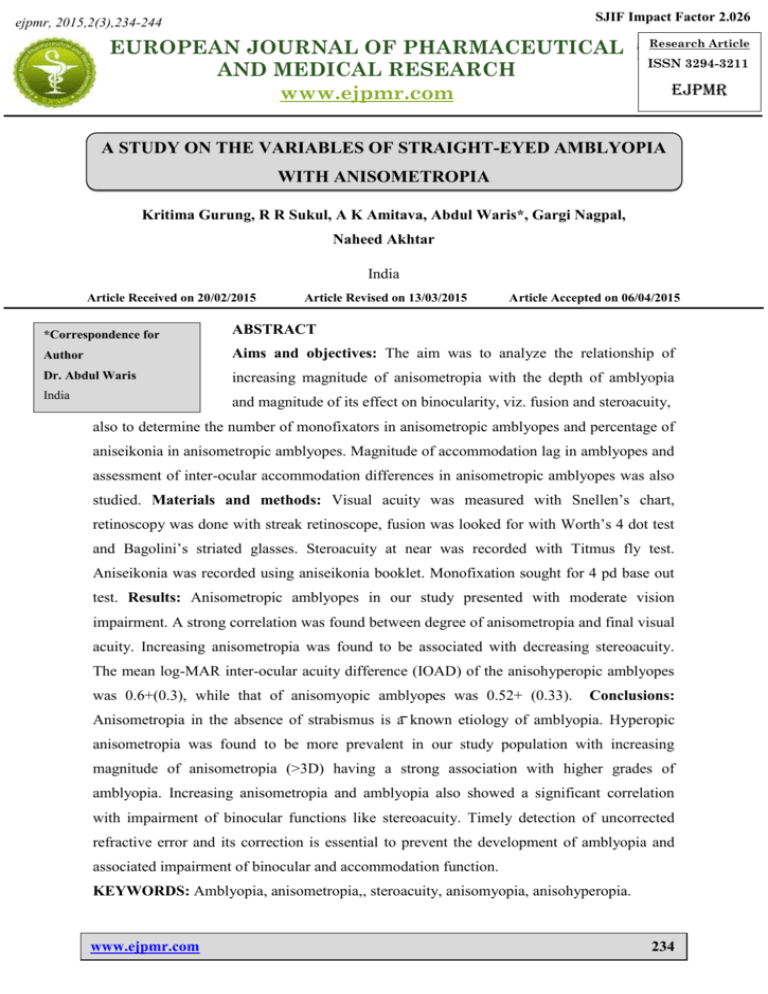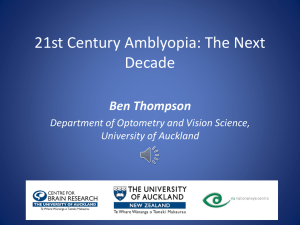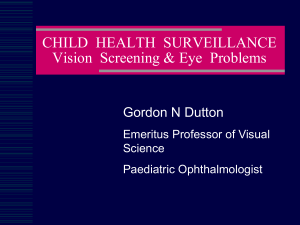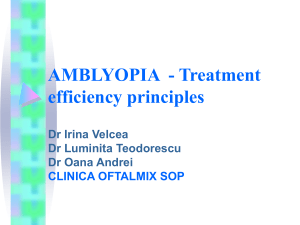Full Text Article - European Journal of Pharmaceutical and Medical
advertisement

SJIF Impact Factor 2.026 ejpmr, 2015,2(3),234-244 Abdul et al. EUROPEAN Research Article European Journal of Pharmaceutical and Medical Research JOURNAL OF PHARMACEUTICAL ISSN 3294-3211 AND MEDICAL RESEARCH EJPMR www.ejpmr.com A STUDY ON THE VARIABLES OF STRAIGHT-EYED AMBLYOPIA WITH ANISOMETROPIA Kritima Gurung, R R Sukul, A K Amitava, Abdul Waris*, Gargi Nagpal, Naheed Akhtar India Article Received on 20/02/2015 Article Revised on 13/03/2015 Article Accepted on 06/04/2015 *Correspondence for ABSTRACT Author Aims and objectives: The aim was to analyze the relationship of Dr. Abdul Waris increasing magnitude of anisometropia with the depth of amblyopia India and magnitude of its effect on binocularity, viz. fusion and steroacuity, also to determine the number of monofixators in anisometropic amblyopes and percentage of aniseikonia in anisometropic amblyopes. Magnitude of accommodation lag in amblyopes and assessment of inter-ocular accommodation differences in anisometropic amblyopes was also studied. Materials and methods: Visual acuity was measured with Snellen’s chart, retinoscopy was done with streak retinoscope, fusion was looked for with Worth’s 4 dot test and Bagolini’s striated glasses. Steroacuity at near was recorded with Titmus fly test. Aniseikonia was recorded using aniseikonia booklet. Monofixation sought for 4 pd base out test. Results: Anisometropic amblyopes in our study presented with moderate vision impairment. A strong correlation was found between degree of anisometropia and final visual acuity. Increasing anisometropia was found to be associated with decreasing stereoacuity. The mean log-MAR inter-ocular acuity difference (IOAD) of the anisohyperopic amblyopes was 0.6+(0.3), while that of anisomyopic amblyopes was 0.52+ (0.33). Conclusions: Anisometropia in the absence of strabismus is a known etiology of amblyopia. Hyperopic anisometropia was found to be more prevalent in our study population with increasing magnitude of anisometropia (>3D) having a strong association with higher grades of amblyopia. Increasing anisometropia and amblyopia also showed a significant correlation with impairment of binocular functions like stereoacuity. Timely detection of uncorrected refractive error and its correction is essential to prevent the development of amblyopia and associated impairment of binocular and accommodation function. KEYWORDS: Amblyopia, anisometropia,, steroacuity, anisomyopia, anisohyperopia. www.ejpmr.com 234 Abdul et al. European Journal of Pharmaceutical and Medical Research INTRODUCTION The term ‘amblyopia’ is derived from Greek, which literally means ‘dullness of vision’.[1] Von Noorden defined it as ‘a decrease of visual acuity in one eye, when caused by abnormal binocular interaction, or occurring in one or both eyes, as a result of pattern vision deprivation during visual immaturity, for which no cause can be detected during the physical examination of the eye and which in appropriate cases is reversible by therapeutic measures’.[2] Anisometropia, a relative difference in the refractive state of the two eyes, is well known to be associated with amblyopia both in the presence and absence of strabismus. A considerable volume of literature supports the supposition that anisometropia alone is a significant risk factor for the development of amblyopia,[3-5] the term ‘anisometropic amblyopia’ is widely accepted to describe this entity.[6] All anisometropes are not amblyopes. The relationship between anisometropia and amblyopia is still not clear. Whether the amount of anisometropia is related to density of amblyopia still remains open for discussion.[5, 7, 8, 9,10] Majority of the investigators now acknowledge such an association does exist. However, the risk of developing amblyopia and/or subnormal binocular vision for a given degree or type of anisometropia has not been quantified previously. Furthermore, when amblyopia develops in association with anisometropia, it remains uncertain if the severity of amblyopia is directly related to the degree or type of anisometropia. It is considered that amblyopic eyes have weak accommodation amplitudes. Kazuhiko et al reported reduced accommodation amplitudes in 22mono-ocular amblyopes. Similar findings were reported by Steven Hokod Kenneth J., however the magnitude of the impairment was not quantified. Little published work exists in this area and we need to know how much is the accommodation in amblyopes, and if it correlates with the amount of anisometropia. We, therefore, designed a cross sectional study to identify the grade (according to the Amblyopia Treatment Study)[11] of amblyopia in patients of anisometropia, to find if there was any correlation between the density of amblyopia and the amount of anisometropia. In addition we studied whether the amount of anisometropia was related to aniseikonia, binocularity, including stereopsis. www.ejpmr.com 235 Abdul et al. European Journal of Pharmaceutical and Medical Research MATERIALS AND METHODS All patients with purely refractive errors and no history of any other ocular pathology serving as the etiology for the decreased visual acuity, manifest strabismus or pathological myopia, were considered as subjects for the study. Also, patients having sought any previous ocular treatment or ocular surgery, and those unable to co-operate because of age or mental status, or unwilling to give informed consent were excluded from our study. 62 anisometropic amblyopes were recruited, 80% of whom were younger than 30 years. Of these, 48 were aniso hyperopes while 14 were anisomyopes. Although, almost 1/4th of them had been prescribed glasses, none were currently utilizing them and none had received any occlusion. The assessment of selected patients included a detailed history, general and detailed ocular examination, including a biomicroscopy and indirect ophthalmoscopy. VA both for distance and near was recorded with Snellen’s chart and converted to logMAR, both uncorrected and with best refractive correction. All patients underwent a dry retinoscopy followed by wet retinoscopy, a week later. Cycloplegia in wet retinoscopy was achieved by instilling cyclopentolate 1% eye drops, 1 drop in each eye at intervals of 10 minutes, for 40 minutes. Its effect was confirmed by absence of any difference in the red reflex on distance and near fixation and by assessing the amount of pupillary dilatation. With the refractive correction in place, fusion was looked for with Worth’s 4 dot test and Bagolini’s striated glasses. Steroacuity at near (with a +3D add) was also recorded with the refractive correction in arcsecs using the Titmus fly test. Aniseikonia was recorded in percentage using the aniseikonia booklet. The presence of monofixation was sought for with the 4 pd base out test. For the purpose of analysis, patients with anisometropia were divided into 4 subtypes 1. Spherical hyperopic anisometropes (SHA) was defined as those in whom The difference in spherical error between the 2 eyes is > +0.5 Dioptres with <1 + D cylindrical error. 2. Spherical myopic anisometropia (SMA) was defined as those in whom The difference in spherical error between the 2 eyes is > -0.5Dioptres with < +1D cylindrical error. 3. Cylindrical hyperopic anisometropia (CHA) was defined as those in whom www.ejpmr.com 236 Abdul et al. European Journal of Pharmaceutical and Medical Research The difference in cylindrical error between the 2 eyes >+1 Dioptres in those with isolated cylindrical errors and spherical equivalent of < + 1.00 D. 4. Cylindrical myopic anisometropia (CMA) was defined as those in whom The difference in cylindrical error between 2 eyes is > -1.00Dioptres in those with isolated cylindrical errors and spherical equivalent of < + 1D. Parameters calculated Mean (SD) acuity in the better eye in log MAR units. Mean (SD) acuity in the worse eye in log MAR units. Inter- ocular acuity difference (IOAD) – mean of the difference in visual acuity between 2 eyes in log MAR. Mean acuity amblyopic eye (corrected patients only) in log MAR. Rate of mono-fixation response in each group was calculated as percentage. Near stereo acuity was measured in sec/arc using the Titmus fly stereoacuity test. Aniseikonia was measured in percentage with the help of the Aniseikonia booklet. Accommodation lag was measured in Dioptres by the MEM DR (mono-ocular estimate, Dynamic retinoscopy) using neutralizing spheres to assess the magnitude of lag. Inter- ocular accommodation difference (better versus worse eye) will also be measured in Dioptres. Accomodation lag was recorded as follows; with the distance correction in place (if needed) the patient will be asked to fixate at a resolving target (letters/drawing) on the head of the streak retinoscope at 1/3 of a meter. Normally, the retinoscopic reflex, during this dynamic refraction, shows a ‘with’ movement, implying that there is an accommodation lag. Plus lenses will be quickly placed before the eye till complete neutralisation is achieved. The amount of plus added will be indicative of the accommodation lag in dioptres. Amblyopia was determined with the best correction and defined as a difference of 2 or more lines between the 2 eyes on the Snellen’s acuity charts or a difference of 3 or more lines on the log MAR charts. The baseline BCVA (best corrected visual acuity) of the amblyopic was the one obtained after 2 weeks of wearing of the best correction, and on obtaining reproducible response when checked on 2 occasions within a week (this was to eliminate improvement of VA on merely correcting the ametropia). The BCVA thus obtained was www.ejpmr.com 237 Abdul et al. European Journal of Pharmaceutical and Medical Research considered for the grading of amblyopia if no further improvement was seen as mild, moderate or severe. In addition aniso-acuity (in log MAR) was calculated for evaluation. Accommodation amplitudes was recorded (in D) by asking the patient to see the N6 letter on near charts with with the best corrected visual acuity and calculating the Diopteric equivalent of the shortest distance nearer to which blurred. This was with the best correction in place for distance. The obtained data was analyzed for their statistical significance using SPSS v 13 (SPSS Inc. Chicago, Illinosis, USA). Data was analyzed by paired t-test, AnOVA, Chi square as appropriate and p value of <0.05 was considered significant. RESULTS The mean (+SD) age of the anisohyperopic amblyopes was 15(+6) years, while that of anisomyopic amblyopes was 32 (+5.4) years. Anisohyperopic amblyopes comprised of twenty-five (52%) males and twenty-three (48%) females while there were nine (64%) males and five (36%) females among the anisomyopic amblyopes. Anisometropic amblyopes in our study presented with moderate impairment of visual acuity. No correlation was found between the age of presentation and the final visual acuity of the amblyopic eye (p=0.12) in our study. However, a strong correlation was present between the degree of anisometropia (spherical equivalent) and final visual acuity (after correction of refractive error) of the amblyopic eye (r=0.85, p significant at 0.01). The mean log-MAR inter-ocular acuity difference (IOAD) of the anisohyperopic amblopes was 0.6+ (0.3) while that of the anisomyopic amblyopes was 0.52+ (0.33). The majority of the study population of 62 amblyopes had moderate (n=33(53%) to severe (n=26(42%) grades of amblyopia with only 3 (5%) having mild grade. Our population of amblyopes, majority (48) of whom were hyperopes with anisometropia of >2D presented to us with mild to severe grades of amblyopia 80% of whom were younger than 30 years of age. Of the entire group, 77% of the anisohyperopes and 78% of the anisomyopes had anisometropia of >2D. The mean anisometropia was 3.5 D (+1.74D) with range from 0.5D to www.ejpmr.com 238 Abdul et al. European Journal of Pharmaceutical and Medical Research 7D. The severity of amblyopia as measured by IOAD (inter-ocular acuity difference) (r=0.81, p significant at 0.01) was strongly associated with spherical hyperopic anisometropia. On comparing the presence of low grade amblyopia (mild to moderate) to high grade (severe) with anisometropia of <2D vs >2D, there was significant association of the presence of high grade amblyopia with >2D of anisometropia as compared to <2D. (p=0.005, OR=2.2, (95% CI, 1.6 to 3.1). As expected, a more significant association of the presence of severe amblyopia with >3D was found (p=0.00, OR=55, (95%CI, 9 to 333). In our analyses, on W4DT, forty one patients demonstrated fusion, while twenty one showed suppression. Thirty seven (60%) had at least gross stereopsis and twenty five (40%) had no stereopsis. The stereacuity was recorded as <200 arc-seconds in thirty (48%) and >200 seconds of arc in seven (12%) amblyopes, the remaining twenty five (40%) had no stereopsis. In our study, on comparing the presence or absence of stereopsis with anisometropia of <2D vs > 2D, there was no significant association of the presence/absence of fusion with anisometropia of <2D vs > 2D (p=0.41, OR=0.37, (95%CI 0.34-30.34). Fusion was significantly likely to be absent with anisometropia >3D, when compared to anisometropia to be associated with decreasing stereoacuity. Among the anisohyperopic amblyopes, the mean amplitude of accommodation (AA) of the amblyopic eye was 7.95 D (+2.08), and that of the non-amblyopic eye was 12.59 D (+2.0); accommodation lag (AL) of amblyopic eye was 1.62 D(+0.76) and that in the non-amblyopic eye was 0.90 D(+0.58); inter-ocular difference (IOD) of AA was 4.58 D (+1.76)(95% CI:4.21-5.16), while AL 0.73D(+0.55)(95%CI, 0.57 to 0.89). There was a significant correlation (p<0.001) between increasing anisometropia and inter-ocular difference in amplitude of accommodation (Pearson coefficient: 0.55) and accommodation lag (Pearson coefficient: 0.50). Thus, there is evidence that accommodation is significantly weaker in the amblyopic eye in anisohyperopic amblyopes, and significantly deteriorates with increasing anisometropia. DISCUSSION The aim of this cross-sectional study was to identify the grade of amblyopia in patients of anisometropia and to analyze the relationship of increasing magnitude of anisometropia with the depth of amblyopia and magnitude of its effect on binocularity, viz. fusion and steroacuity, also to determine the number of monofixators in anisometropic amblyopes and www.ejpmr.com 239 Abdul et al. European Journal of Pharmaceutical and Medical Research percentage of aniseikonia in anisometropic amblyopes. Magnitude of accommodation lag in amblyopes and assessment of inter-ocular accommodation differences in anisometropic amblyopes was also studied. Clinically amblyopia is considered to be present if a difference of > 2 lines on Snellen’s (or > 3 lines on log MAR) is present between the 2 eyes after best refractive correction. A reduction in the best corrected visual acuity on Snellen’s chart of <6/12 quantifies as bilateral amblyopia. The Amblyopia Treatment Study graded amblyopia as mild, moderate and severe according to the amount of reduction in the best corrected central visual acuity on Snellen’s chart. Grade Mild Moderate Severe Best corrected visual acuity of Better than 6/12 6/12 to 6/24 Worse than 6/24 to better than 3/60 Anisometropia in the absence of strabismus is a known etiology of amblyopia. Hyperopic anisometropia was found to be more prevalent in our study which was 77% as compared to 23% anisomyopic amblyopes. Majority of the study population of 62 amblyopes, had moderate (n=33(53%)) to severe (n=26(42%)) grades of amblyopia with only 3(5%) having mild grade of amblyopia. Anisometropia may produce amblyopia either by causing a loss of foveal resolution in the less focussed eye, by localized mechanisms of foveal inhibition (development of a suppression scotoma), or by loss of stero-acuity and binocular function (perhaps caused by loss of resolution or by a suppression scotoma). Tomac and Birdal[12] evaluated binocular function and fusion in anisometropic adults and found that amblyopia depth was more related to a deterioration in binocularity than to the magnitude of the anisometropia. Dadeya and colleagues[13] have demonstrated that normal individuals, with induced anisometropia, have a deterioration in binocular vision with increasing levels of anisometropia, and this may determine which eyes become amblyopic. Further analysis of the anisometropic children in the cohort reported originally by Abrahamsson and colleagues[14] demonstrated that (1) 60% of children with anisometropia greater than 3 dioptres developed amblyopia, (2) an increasing amount of anisometropia over time was associated with amblyopia development in all cases, and (3) 90% of children with www.ejpmr.com 240 Abdul et al. European Journal of Pharmaceutical and Medical Research anisometropia greater than 3 dioptres at 1 year of age had at least that amount at age 10 years.[15] Woodgruff and associates[16] found that the age of presentation for patients with anisometropic amblyopia (5.6 years) was much greater than that for patients with other types of amblyopia. Weakley’s study demonstrated an increased risk of amblyopia once spherical hypermetropic anisometropia exceeded 1 Diopter.[17] It was also associated with an increasing depth and prevalence of amblyopia. Similar results were seen with spherical myopic anisometropia of greater than 2 diopters, although the sample size was much smaller. Weakley and associates[17,18] also studied the effect of anisometropia on the development and breakdown of accommodative esotropia. In this evaluation, anisometropia greater than or equal to 1 diopter increased the risk of developing accommodative esotropia. In our study, the mean BCVA (log MAR) of the amblyopic eye among the anisohyperopic amblyopes was 0.6+(0.24) and the anisomyopic amblyopes had a mean BCVA (log MAR) of 0.62+(0.27) in the amblyopic eye. Patients presented to us at a later age (15+6 years) i.e. beyond the critical period (6-8 years). No correlation was found between the age of presentation and the final visual acuity of the amblyopic eye (p=0.12) was found in our study. A trend for worsening acuity in the worse eye, increased inter-ocular acuity difference became apparent as anisometropia increased in magnitude. The mean anisometropia was 3.5D (+1.74D) with range from 0.5D to 7D. The severity of amblyopia as measured by IOAD (inter-ocular acuity difference) (r=0.81, p significant at 0.01) was strongly associated with spherical hyperopic anisometropia. Increasing magnitude of anisometropia (>3D) showed a strong association with higher grades of amblyopia (p=0.00, OR=55, (95%CI, 9 to 333)). Thirty seven (60%) had at least gross stereopsis and twenty five (40%) had no stereopsis. The stereoacuity was recorded as <200 arc seconds in thirty (48%) and >200 seconds of arc in seven (12%) amblyopes, the remaining twenty five (40%) had no stereopsis. Fusion was significantly likely to be absent with anisometropia >3D, when compared to anisometropia of www.ejpmr.com 241 Abdul et al. European Journal of Pharmaceutical and Medical Research < 3D (p<0.001;OR=27.28, 95% CI 3.14-235). The severity of amblyopia and subnormal binocularity was related to the degree of anisometropia. There was a significant correlation (p<0.001) between increasing anisometropia and interocular difference in amplitude of accommodation (Pearson coefficient: 0.55) and accommodation lag (Pearson coefficient: 0.50). Thus, there is evidence that accommodation is significantly weaker in the amblyopic eye in the amblyopic eye in the anisohyperopic amblyopes, and significantly deteriorates with increasing anisometropia. CONCLUSIONS Anisometropia in the absence of strabismus is a known etiology of amblyopia with patients presenting at a later age (15+6 years) i.e. beyond the critical period (6-8 years) because uncorrected refractive errors in the absence of strabismus go undetected due to the lack of awareness. Hyperopic anisometropia was found to be more prevalent in our study with increasing magnitude of anisometropia (>3D) having a strong association with higher grades of amblyopia. However the age at presentation had no correlation with the final visual acuity of the amblyopic eye. Increasing anisometropia and amblyopia also showed a significant correlation with impairment of binocular functions like stereoacuity. With respect to accommodation lag and amplitudes in amblyopes, impairment of accommodation amplitudes along with significant accommodation lag was found. Many questions with regard to the association of impaired accommodation with amblyopia remain unanswered. Few investigators have labelled accommodation lag as one of the etiological factors for the development amblyopia,[19] while others have considered it to be the effect of poor vision.[20] Thus, timely detection of uncorrected refractive error, and its correction is essential to prevent the development of amblyopia and associated impairment of binocular and accommodation function. REFERENCES 1. Vital-Durand F, Ayzac L. Tackling amblyopia in human infants. Eye, 1996; 10: 239-244. 2. Gunter K. Von Noorden M.D. Binocular vision and ocular motility, 6th edition, 246-247. www.ejpmr.com 242 Abdul et al. European Journal of Pharmaceutical and Medical Research 3. Abrahamson M, Fabian G, Sjostrand J. A longitudinal study of a population based sample of astigmatic children. II. The changeability of anisometropia. Acta Ophthalmol, 1990; 68: 4: 35-440. 4. American Academy of Ophthalmology; Amblyopia Preferred Practice Pattern. San Francisco, 1997; 5-6. 5. De Voters J. Anisometropia in children: Analysis of a hospital population. Br J Ophthalmic, 1985; 69: 504-507. 6. Philips CL. Strabismus, anisometropia, and amblyopia. BrJ Ophthalmol, 1976; 24(III): 10-13. 7. Ingram RM. Refraction as a basis for screening children for squint and amblyopia. Br J Ophthalmic 77; 61: 8-15. 8. Vital-Durand F, Ayzac L. Tackling amblyopia in human infants. Eye, 1996; 10: 239-244. 9. Copps LA. Vision in anisometropia. Am J Ophthalmo 7: 641-644. 10. Townshend AM, Holmes JM, Evans LS. Depth of anisometropic amblyopia in difference in refraction. Am J. Ophthalmol, 1993; 116: 431-436. 11. Paediatric Eye Disease investigator group. The course of moderate Amblyopia with patching in children: Experience of the Amblyopia Treatment Study. AJO, 2003; 136: 620-9. 12. Tomac S, Birdal E. Effects of anisometropia on binocularity. J Pediatr Ophthalmol Strabismus, 2001; 38: 27-33 [Pubmed]. 13. Dadeya S, Kamlesh, Shibal F. The effects of anisometropia on binocular visual function. Indian J Ophthalmol, 2001; 49: 261-263. [Pubmed] 14. Abrahamsson M, Fabian G, Sjostrand J. A longitudinal study of a population based sample of astigmatic children. II. The changeability of anisometropia. Acta Ophthalmol (Copenh), 1990; 68: 435-440. [Pubmed]. 15. Abrahamsson M, Sjostrand J. Natural history of infantile anisometropia. Br J Ophthalmol, 1996; 80: 860-863. [Pubmed]. 16. Woodruff G, Hiscox F, Thompson JR, et al. The presentation of children with amblyopia. Eye, 1994; 8: 623-626. [Pubmed]. 17. Weakley DR. The association between anisometropia, amblyopia, and binocularity in the absence of strabismus. Trans Am Ophthalmol Soc. 1999; 97:987-1021. [Pubmed]. 18. Weakley DR., Jr The association between non strabismic anisometropia, amblyopia and subnormal binocularity. Ophthalmology, 2001; 108: 163-171. [Pubmed]. www.ejpmr.com 243 Abdul et al. European Journal of Pharmaceutical and Medical Research 19. Pollard ZF, Manley D, Long term results in the treatment of unilateral high myopia with amblyopia. American Journal of Ophthalmology, 1974; 78: 397-9. 20. Hung GK, Ciuffreda KJ, Semmlow JL, Hokoda SC. Model of static accommodative behaviour in human amblyopia. IEEE Trans Biomed Eng, 1983; 30: 665-672. 21. Flom MC, Bedel II E. Identifying amblyopia using associated conditions, acuity, and acuity features. Am71 J Optom Physio Opt, 1985; 62: 1543. 22. Brooks SE, Jolmson D, Fischer N. Anisometropia and binocularity. Ophthalmology, 1996; 103(7): 1139-1143. 23. David A. Lee, Evan J. Higginbahan. Clinical Guide to Comprehensive Ophthalmology. 24. Menon V, Chandhuri Z, Saxena R. Gill K, Sachdeva MM. Classification of amblyopia. Indian J. Opthalmol. 2006; b J4 (3): 212 25. McKee SP, Levi DM, Movshon JA. The pattern of visual deficits in amblyopia. J Vis. 2003; 3: 380-405 [Pubmed]. 26. McKerral M, Polomeno RC, Lepore F, et al. Can inter ocular pattern reversal visual evoled potential and motor reaction time differences distinguish anisometropic from strasbismic amblyopia? Acta Ophthalmol Scand, 1999; 77:40-44. [Pubmed]. 27. Wensveen JM, Harwerth RS, Smith EL., III Binocular deficits associated with early alternating monocular defocus. I. Behavioral observations. J Neurophysiol, 2003; 90: 3001-3011. [Pubmed]. 28. Oguz H, Oguz V. The effects of experimentally induced anisometropia on stereopsis. J Paediatric Ophthalmol Strasbismus, 2000; 37: 214-218. [Pubmed]. 29. Sen DK Anisometropic amblyopia, Journal of Paediatric Ophthalmology Strabismus, 1980; 17: 180-4. 30. Quasi-static study of accommodation in amblyopia. (Kazuhiko, Makiko Ishni, Santoshi Ishikawa). Ophthalmic and physiological optic. Journal of optometrists. Vol 6, issue 3, pg 287-295. Published 19, 2007. 31. Ong E, Ciuffreda KJ, Tannen B. Static accommodation in congenital nystagmus. Invest Ophthalmol Vis Sci, 1993; 34: 194-204. www.ejpmr.com 244





![INITIAL ENTRY [headstart - fourth (4) grade]](http://s3.studylib.net/store/data/007186926_1-bbcbbac65c6b7e51aa650c936c0e7792-300x300.png)


